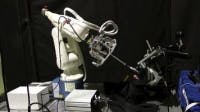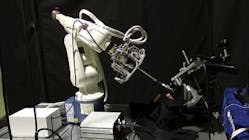Avision-enabled robot that was inspired by the robotic arms used to help astronauts build the International Space Station is now being developed by a team of researchers in order to assist in minimally invasive pediatric surgery.
The system, called KidsArm, is being developed by the Hospital for Sick Children (SickKids) Center for Image-Guided Innovation & Therapeutic Intervention (CIGITI)along with MacDonald, Dettwiler and Associates Ltd., the company that developed the space shuttle’s robotic arms. KidsArm will allow surgeons to quickly navigate to surgical sites in the body via an advanced imaging and control system that enables precise movements.
Specifically, a pair of aCA 1300 30gc aceGigE cameras from Basler was used to generate 3D point clouds that guide the tool tip for the surgery. These 1.2 MPixel cameras feature 1/3" Sony ICX445 CCD image sensors with a 3.75 µm x 3.75 µm pixel size and a 30 fps frame rate. The cameras and a high-intensity fiber light source form the input sensor for the image processing unit, which provides image guidance input to the robot and tool controller.
MORE ARTICLES
Vision-guided robot speeds optical filter analysis
Industrial robots help create 80,000 jobs in electronics industry
Researchers develop robotic arm that can catch fast moving objects
The cameras are separated side by side by 4 cm and held in place by a flexible universal joint. The average distance from the camera to the surface of the target area is 12 cm.3D reconstruction, image rectification, and camera calibration functions from OpenCV were used to obtain the 3D point cloud data of the mockup tubular vessels, and image feature extraction, tool target tracking, and deformable lumen tracking algorithms were implemented as part of the project.
In addition to the image processing unit, the KidsArm robot is comprised of three subsystems: The anastomosis tool, arobotic arm, and a robotic controller. The anastomosis tool is based on a Covidien SILS Stitch articulating suturing device, with two joints providing pitch and roll of the tip, plus an active grasper capable of moving forward and reverse for thread management. The tool is carried by a Denso VP6 articulated arm.
Page 1 |Page 2








